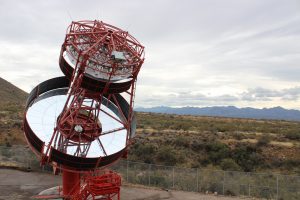
Researchers at The University of Alabama are part of an international team of scientists that used a new prototype telescope to detect energetic gamma rays from the Crab Nebula, the remnant of a supernova explosion, opening doors for future discoveries.
The Schwarzschild-Couder Telescope, which began operations in Arizona earlier this year, detected gamma rays from the Crab Nebula, the brightest steady source of very-high-energy gamma rays in the sky, as a way of proving the telescope’s technology.
“Gamma rays are the highest energy form of light and, as such, they reveal some of the most energetic objects in the universe, such as supermassive black holes at the cores of distant galaxies or supernova remnants, in ways that would not be possible with visible light alone,” said Dr. Marcos Santander, UA assistant professor of physics and astronomy. ”The technology in this telescope will revolutionize gamma-ray astronomy at the highest observable energies in the coming decades.”
Santander and two students, doctoral student Weidong Jin and recent computer science graduate Jacob Powell, are part of the development of control and monitoring software for the telescope. Santander is part of the Cherenkov Telescope Array consortium, a global initiative of over 1,500 scientists and engineers from 31 countries engaged to build the world’s largest and most sensitive very-high-energy gamma-ray observatory consisting of about 120 telescopes split into a southern array at Parallel, Chile and a northern array at La Palma, Spain.
The detection of gamma rays from the Crab Nebula was announced at the 236th meeting of the American Astronomical Society.
Detecting the Crab Nebula with the prototype telescope in Arizona is more than just proof-positive for the telescope itself. It lays the groundwork for the future of gamma-ray astrophysics, said Dr. Justin Vandenbroucke, associate professor at the University of Wisconsin-Madison.
“We’ve established this new technology, which will measure gamma rays with extraordinary precision, enabling future discoveries. Gamma-ray astronomy is already at the heart of the new multi-messenger astrophysics, and the SCT technology will make it an even more important player,” Vandenbroucke said.
The use of secondary mirrors in gamma-ray telescopes is a leap forward in innovation for the relatively young field of very-high-energy gamma-ray astronomy, which has moved rapidly to the forefront of astrophysics. The initial Crab Nebula detection was made possible by leveraging key simultaneous observations with the co-located VERITAS, Very Energetic Radiation Imaging Telescope Array System, gamma-ray observatory.
Located at the Fred Lawrence Whipple Observatory in Amado, Arizona, the Schwarzschild-Couder Telescope was inaugurated in January 2019 and saw first light the same week. After a year of commissioning work, scientists began observing the Crab Nebula in January 2020, but the project has been underway for more than a decade.
The construction of the telescope was made possible by the contributions of 30 institutions and five critical industry partners across the United States, Italy, Germany, Japan and Mexico along with funding through the U.S. National Science Foundation Major Research Instrumentation Program. Now demonstrated, the current and upcoming innovations will lay the groundwork for use in the future Cherenkov Telescope Array observatory.
